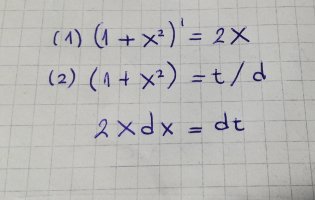You are using an out of date browser. It may not display this or other websites correctly.
You should upgrade or use an alternative browser.
You should upgrade or use an alternative browser.
Derivative issue
- Thread starter Loki123
- Start date
BeachBanana
Senior Member
- Joined
- Nov 19, 2021
- Messages
- 2,281
The instruction needs to tell you to take the derivative, but with respect to what variable?
In (1), since there is only x, we can assume that it's respect to x.
In (2), you have 3 "unknowns", namely x,t and d. What are you differentiating with respect to?
In (1), since there is only x, we can assume that it's respect to x.
In (2), you have 3 "unknowns", namely x,t and d. What are you differentiating with respect to?
Steven G
Elite Member
- Joined
- Dec 30, 2014
- Messages
- 14,603
Although I do not support the notation of /d, it means to take the derivative of both sides.The instruction needs to tell you to take the derivative, but with respect to what variable?
In (1), since there is only x, we can assume that it's respect to x.
In (2), you have 3 "unknowns", namely x,t and d. What are you differentiating with respect to?
BeachBanana
Senior Member
- Joined
- Nov 19, 2021
- Messages
- 2,281
That's a new one to me and I do not support it either! I was thinking division. That cleared up the OP.Although I do not support the notation of /d, it means to take the derivative of both sides.
topsquark
Senior Member
- Joined
- Aug 27, 2012
- Messages
- 2,363
Icky notation!Although I do not support the notation of /d, it means to take the derivative of both sides.
-Dan
Dr.Peterson
Elite Member
- Joined
- Nov 12, 2017
- Messages
- 16,871
Can you show documentation of this? I've never heard of such a notation, and it's certainly unclear.Although I do not support the notation of /d, it means to take the derivative of both sides.
I'd like to see the entire context in which this was presented. I'm guessing it's just something informal used at the board while talking, and not a written notation.
Steven G
Elite Member
- Joined
- Dec 30, 2014
- Messages
- 14,603
We have all seen this before on this forum. I am not going to spend a lot of time looking for an example but will try for a few minutes.Can you show documentation of this? I've never heard of such a notation, and it's certainly unclear.
I'd like to see the entire context in which this was presented. I'm guessing it's just something informal used at the board while talking, and not a written notation.
Yes, the only times I have seen it is when we write on the board, however, we write it constantly like that.Can you show documentation of this? I've never heard of such a notation, and it's certainly unclear.
I'd like to see the entire context in which this was presented. I'm guessing it's just something informal used at the board while talking, and not a written notation.
BeachBanana
Senior Member
- Joined
- Nov 19, 2021
- Messages
- 2,281
Did that clear up your confusion about the question?Yes, the only times I have seen it is when we write on the board, however, we write it constantly like that.
i think so. But could you tell me what's the difference between differential and derivative?Did that clear up your confusion about the question?
Steven G
Elite Member
- Joined
- Dec 30, 2014
- Messages
- 14,603
I am not going to get into the definition of what a differential is but you mostly use it for integrals. Can you tell us exactly what you are using differentials for?i think so. But could you tell me what's the difference between differential and derivative?
Up until now I didn't know the difference, but from what I can see, we do use it for integrals only.I am not going to get into the definition of what a differential is but you mostly use it for integrals. Can you tell us exactly what you are using differentials for?
BeachBanana
Senior Member
- Joined
- Nov 19, 2021
- Messages
- 2,281
Let [imath]\triangle x[/imath] be the change in x, then [imath]\triangle y = f(x+\triangle x)-f(x)[/imath] is the change in y corresponding to how x change. Differentials have practical applications in estimating the max/min potential errors in measurements like volume, area, length, etc... Also, separation of variables to solve differential equations (integration as Steve mentioned).i think so. But could you tell me what's the difference between differential and derivative?
Last edited:
The differential, \(\displaystyle \frac{df}{dx}\), is NOT a fraction. It is defined as a limit of fractions: \(\displaystyle \frac{df}{dx}= \lim_{\Dellta x\to 0}\ frac{\Delta y}{\Delta x}\), But it turna out that the derivative can be treat like a fraction. To formalize that we define the "differentials", dx, purely symbolic, and dy, defined as f'(x)dx so that \(\displaystyle \frac{dy}{dx}= f'(x)\) is a fraction.

